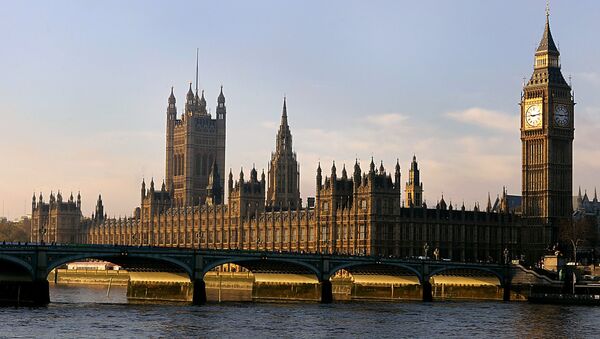The Leader of the Commons, Andrea Leadsom, said on Tuesday, October 24, the government was proposing to delay until 2019, a final decision on renovating the Houses of Parliament.
"It is vital that parliamentarians eventually return to the seat of our democracy, and the action taken now will ensure Britain has a world leading parliament fit for the 21st century," said Mrs. Leadsom.
I have updated the House on EU (Withdrawal) Bill committee stage and important progress on restoration of Parliament https://t.co/lc9SYwlUvV
— Andrea Leadsom MP (@andrealeadsom) 26 October 2017
MPs are set to debate a motion on the renovation in December, but David Lowe, a former police officer and counterterrorism consultant, said it would be important to set up better security for those working in the building, especially after the attack in March in which PC Keith Palmer was stabbed to death.
"Overall the response to that attack was good but questions were asked about why he was unarmed. You want to be as open as possible but you can't open yourselves up to terrorists," Mr. Lowe told Sputnik.
Security Review After March Attack
A spokesperson for the Houses of Parliament restoration and renewal team said there had been a review about the attack in March, but its recommendations would remain secret for reasons of national security.
"But the findings will inform any final design," the House of Parliament spokesperson told Sputnik.
#OTD 1834 most of medieval Palace of Westminster destroyed by fire. Commons and Lords chambers destroyed, Westminster Hall saved. pic.twitter.com/P6JxJCd3oM
— PARLY (@ParlyApp) 16 October 2017
There has been a gradual increase in security at the Palace of Westminster — often known as the "home of democracy" — over the years.
In March 1979 Conservative MP Airey Neave, who would have been Northern Ireland Minister in Margaret Thatcher's first government, was killed by a car bomb planted by the Irish National Liberation Army (INLA). That led to much greater security, especially for MPs coming in and out of the building by car.
Govt announces debate on Palace of Westminster #restoration, likely to be in #HouseofLords in Dec. Learn more https://t.co/h7hFMfhoFp pic.twitter.com/9MVJW0MsW7
— House of Lords (@UKHouseofLords) 24 October 2017
Chance to Put in 'Really Good' Security
In the 1990s a new entrance foyer was built at the front of the building, with scanners and bag checks, and in 2004, after purple flour was thrown at then Prime Minister Tony Blair, a glass screen was installed in the public gallery.
But now the threat from Daesh, from Islamist lone wolves and from the far-right, is far more serious.
"There have been a lot of changes over the years. Airey Neave was the first time there was a realization of what could happen and things were tightened up a lot after that. But now they have the chance to put in really good security measures," Mr. Lowe told Sputnik.
"For example is there an escape route if the building comes under attack and how safe are MPs if someone strikes the outside of the building," said Mr. Lowe, pointing out that in 1991 the Provisional IRA fired mortar bombs at 10 Downing Street.
He said even if Daesh was destroyed in Iraq and Syria the threat from Islamists will exist for many years.
"For a generation you will have this threat. It's the ideology that's hard to kill. Daesh learnt from al-Qaeda, when they lost a lot of territory, and they have changed their tactics. Instead of urging people to come and join them in Syria they are now encouraging people to carry out attacks in their home countries," said Mr. Lowe.
"There are hundreds of returning fighters and there could be sleeper cells here," Mr. Lowe told Sputnik.
Two Options on the Table
The Palace of Westminster was built in the mid-1800s — although some bits date back to 1099 — and is in dire need of massive repair works.
There two options — decanting all MPs and peers for six years and renovating the Palace of Westminster at an estimated cost of $4.6 billion (£3.5 billion) or a rolling program of repairs over 32 years, costing $7.5 billion (£5.7 billion).
The latter option would mean MPs could stay in the building during the renovations.
Considering the prohibitive cost of the rolling program, the government favors the decant option, which would mean MPs moving to Richmond House — currently home of the Department of Health — and peers moving into the Queen Elizabeth II Conference Centre for six years.
Delivery Authority to Find Best Options
Ms. Leadsom wants to set up a delivery authority, like the one which supervised the London 2012 Olympics, to work up proposals over the next 18 months.
@andrealeadsom: "Action taken now will ensure we have a world leading parliament fit for the 21st century." https://t.co/mZb0CvmIwV pic.twitter.com/40SOkzkksP
— Leader's Office (@CommonsLeader) 24 October 2017
"What I am trying to do is to really get a grip on this and to facilitate a decision by Parliament," said Mrs. Leadsom, who ran for the leadership of the Conservative Party last year, but lost out to Theresa May.
"Parliament faces significant risks on a daily basis that threaten the safety and health of those who work and visit, as well as the very fabric of the building itself. The longer Parliament puts the decision of restoration off, the higher the final cost to taxpayers will be," she said.
But some MPs are said to be keen to press on and make a decision now, rather than waiting until 2019.


